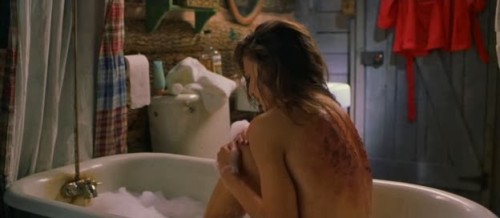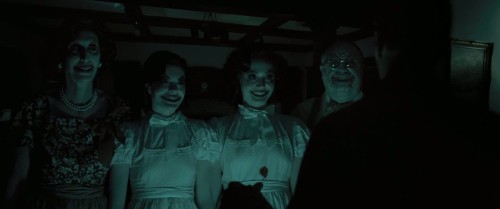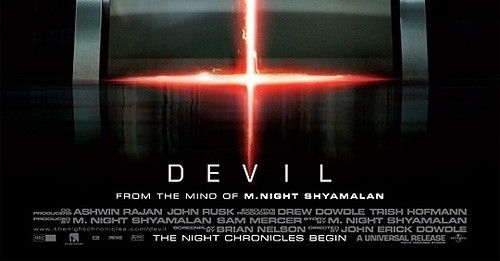10 Horribly Overrated Modern Horror Films
In recent years, almost every time I’ve watched a film dubbed as “this year’s scariest horror film” or “scariest film ever”, I’ve ended up rolling my eyes and wondering if some of these critics have ever seen a horror film before.
So, for Halloween I’ve compiled a list of 10 overrated horror films from the past 15 years. This list is by no means definitive and it is not to say that the films are terrible – some are good – but despite their strengths and weaknesses, all 10 films have been hyped up to be something they simply are not.
- Mama (Andres Muschietti, Spain-Canada, 2013)
Seeing Guillermo del Toro’s name attached to Mama, and already being a fan of The Devil’s Backbone (El espinazo del Diablo, 2001) and Pan’s Labyrinth (El laberinto del fauno, 2006), as well as J A Boyona’s The Orphanage (El Orfanto, 2007), on which del Toro served as executive producer, I was looking forward to seeing this movie.
Two young girls, Victoria and Lilly, are left to fend for themselves in the wild after their father’s attempts to kill them and then himself are thwarted and he is duly killed by an unknown entity. Fast forward a few years and the sisters have become feral, and have been fostered by the entity that killed their father; an entity they call ‘Mama’. The girls are rescued by their uncle and reintroduced into society, but Mama isn’t giving up her claims to Victoria and Lilly that easily.
It’s an interesting story, with many positive reviews. It substitutes gore in favour of building a suspenseful atmosphere with the genre-typical ‘jumpy’ moments, but there comes a point (approximately three quarters of the way through) where the film loses its fear factor in one simple frame: the revelation of Mama.
CGI can do a lot of things, such as create the hauntingly beautiful backdrop the film has, but one thing it cannot do is create anything more horrifying than the mind’s eye. A monstrous character lurking in the shadows, seen only in fleeting glimpses, will always be scarier than one that’s put right in front of us. Our mind will always come up with something scarier than what the monster actually is, so when Mama is revealed in all her ragged glory, the fear and mystery surrounding her character is taken away in a “is that all?” type of moment.
This doesn’t ruin the film, or render it a ‘bad’ film, but it does take away claims (and there were a lot at the time of release) that it is one of the scariest films of the year/decade/etc.
A beautifully dark fairytale? Yes. A terrifying horror film? No.
- The Wolfman (Joe Johnston, USA, 2010)
There was a lot of attention surrounding the release of Joe Johnston’s The Wolfman in 2010, a remake of George Waggner’s 1941 film of the same name. Changes in directors, rewrites and creative differences put the film’s release back 18 months and therefore added to the anticipation.
Much like a lot of films these days, The Wolfman is laden with CGI and special effects, but these do nothing to save it from a script that falls flat on its face; lacking in suspense and failing to evoke much emotion from the viewer. All the problems and setbacks suffered in the production process show through in the final picture, with Universal Pictures president Ronald Meyer describing it as “one of the worst movies we ever made.”
With its atmospheric, creepy locations and Victorian settings, there was a lot of scope for plot development and exploration in The Wolfman, but none of it came to fruition. Under-developed and overrated, the most terrifying thing about The Wolfman is that I actually wasted money watching it at the cinema.
- The Village (M Night Shyamalan, USA, 2004)
Where to start with The Village? Perhaps not too much should be expected from a film given a 12 rating by the British Board of Film Classification [PG-13 for those in the US] but, back in 2004, this film was a big deal. Going to the cinema with my friends was a day long adventure and meant travelling nearly two hours on the bus from my village to the nearest town with a cinema, wasting pocket money on junk food and generally feeling grown up, like we’d escaped to the big wide world for a day. So, a film had to look good for us to make the effort, and this particular summer The Village was all anyone was talking about, for reasons I still cannot fathom.
The film’s creepy premise of an isolated village in 19th century Pennsylvania, cut off from the outside world by dense forest haunted by mysterious red creatures, but in dire need of medicine from the towns outside the forest, is an interesting one with a lot of potential. But, the final product is a complete let down. There are the odd few jumpy moments, but they don’t make up for the bizarre plot twist at the end, which is possibly one of the biggest cinematic anticlimaxes of recent years and only one step up from the ‘it was all a dream’ trope.
Rather than being in the 19th century, we are in the present day, and the titular village is a social construction of sorts, created by a group of people who wanted to retreat from society and use the red creatures (who aren’t actually real) as a way of keeping the younger villagers inside the village and away from the truth. Strange plot twists can be a good idea, not to mention being a good way of throwing the audience off kilter and subverting our expectations, but for it to work, the plot twist itself has to be a good one, and this one is not!
- Devil (John Erick Dowdle, USA, 2010)
Shortly after a man commits suicide by jumping from the 35th floor of a Philadelphia office building, five strangers with dubious pasts are all trapped in a lift in the same building. Security guard Ramirez re-counts stories his mother told him about the devil taking a human form and hunting down sinners while they are still alive, and his suspicions are raised by ghostly figures on the building’s CCTV, but is dismissed by his boss as nothing more than superstition. As the lights begin to flicker and the power goes on and off, each power-cut results in an evil deed and the occupants of the lift begin to die one by one, with the devil being revealed to be amongst them.
It is an interesting and promising premise, and with twists and turns along the way Devil had the potential to be a brilliantly scary horror film, weaving in its fable about good and evil, and heaven and hell, in the modern world. But, it wasn’t. The complicated plot was left only half developed in a bid to get the story told and wrapped up in its 80 minute running time, resulting in a rushed and forced story heavily reliant on genre clichés.
With M Night Shyamalan attached to the project as executive producer and original plans for a trilogy focusing on the supernatural in a modern, urban society, Devil was a hotly anticipated film at the time of release. But, with none of the planned sequels having materialised in the intervening years, and the exciting premise not paying off, Devil sunk faster than a broken lift in a 35 story building.
- Shrooms (Paddy Breathnach, Ireland-Denmark, 2007)
In contrast to The Village and its ‘none of it was actually real’ style ending, Shrooms goes the opposite way, explaining everything that was thought to be nightmares and bad magic mushroom trips is actually a reality.
Back in 2007 everyone at college was fascinated by this film called Shrooms and how scary it was, but it wasn’t until a while after it was released that I finally got around to seeing it, and I was left rather underwhelmed. Another case of an interesting premise being poorly executed, Shrooms is the story of a group of friends camping in the grounds of an old abandoned children’s home, planning on spending their trip consuming magic mushrooms. However, after accidentally ingesting a deathcap mushroom, Tara experiences hallucinations wherein she and all her friends die. In a twist of fate, it is revealed as the character’s reality and Tara has been killing off her friends one by one, as well as a few others she comes into contact with.
An idea that promised so much, Shrooms is a typical low budget horror film filled with lukewarm performances, but the actors themselves can hardly be blamed given how uninspiring the script is. It may have done the rounds in schools and colleges as a terrifying horror film, but it definitely isn’t one.
- Cabin Fever (Eli Roth, USA, 2002)
In the past 13 years a small group of horror filmmakers have been described by many critics as the ‘Splat Pack’; directors who have become known for producing low(ish) budget, 18-rated horror films characterised by extreme ultra-violence, sex and gore. With the Splat Pack including directors such as Eli Roth, Rob Zombie, James Wan and Darren Lynn Bousman, their roster of films have achieved a cult following, as well as polarised reviews from critics and cinema goers alike.
Eli Roth’s directional debut Cabin Fever was the second film in the Splat Pack’s repertoire, (Neil Marshall’s Dog Soldiers was the first), taking the concept of cabin fever and turning it into a story about a flesh-eating virus that strikes a group of college students during their weekend of partying and excess in an isolated forest cabin.

Inspired by horror classics such as The Texas Chainsaw Massacre, Evil Dead and The Last House on the Left, there is nothing inherently wrong with Cabin Fever – it is a decent film with a fairly well thought out plot – but its fear factor comes from blood, guts and gore rather than atmosphere and genuine, heart-pounding scares.
Rather than reinventing the genre Roth pays tribute to it, borrowing elements from slashers and classics, and, in doing so, the film becomes rather clichéd. In the end, it was just another cabin in the woods film, and we’ve seen it all before.
- The Ring (Gore Verbinski, USA, 2002)
Hollywood has a special knack for taking magnificent foreign language films, remaking them in English and ruining them completely. Gore Verbinski’s remake of the critically acclaimed Japanese Horror Ring (Ringu, Hideo Nakata, 1998) is no exception.
This big budget remake starring Naomi Watts is full of under developed characters, nonsensical plot twists and an attempt at trading gore for a creepy atmosphere that just doesn’t pay off. At a time when a big part of the genre has developed an obsession for gore, fake blood and sexual abuse, it is refreshing to see a film that relies more on the atmosphere and tension for thrills than someone getting chopped in half by a garage door. However, if the atmosphere isn’t there and the story isn’t right, then there is very little left over to make us jump and scream.
The Ring paved the way for a number of big budget Hollywood remakes of Japanese horrors including The Grudge (2004), Dark Water (2005) and One Missed Call (2008), none of which lived up to the hype nor the standard of their Asian originals.
Isn’t it time we stopped being lazy and started reading subtitles? Or, heaven forbid, learned another language, and stopped ruining fantastic films with lethargic, boring remakes?
- Drag Me to Hell (Sam Raimi, USA, 2009)
Widely dubbed the ‘scariest horror film of the year’ as well as the ‘scariest horror film of all time’, Drag Me to Hell was massively hyped up from the word go. But, as the old saying goes: ‘the bigger they are, the harder they fall’.
Set in present day Los Angeles, Drag Me to Hell follows mild mannered bank employee Christine when, in a bid to prove to her boss she deserves promotion over colleague Stu, she refuses a mortgage extension to elderly Hungarian gypsy named Mrs Ganush. After being humiliated by Christine, Mrs Ganush vows revenge, and boy does she get it. In one last act before her death Mrs Ganush curses Christine, leading to her being stalked by a demon named the Lamia for three days before it literally drags her to hell.
So much promise, so little deliverance.
Few films are able to successfully tow the line between horror and comedy and still be taken seriously, and in his attempts to blend humour into this psychological, supernatural horror, director Sam Raimi manages to fail on both fronts. Add this to the sub-standard acting of stars Alison Lohman and Justin Long, an over ambitious but ultimately lazy plot, and an evil spirit with the same name as the Greek child-eating demon (even though there is nothing to connect the Greek Lamia to this Californian goat demon Lamia), and what results is a waste of time and money.
Overrated and underdeveloped, the most terrifying thing about Drag Me to Hell is the scene where Christine murders her pet kitten, thinking a simple pet murder will appease the demon on her shoulder. Yes, this particular crazy cat lady is still angry about that scene six years later.
- Paranormal Activity (Oren Peli, USA, 2009)
When I first heard about Paranormal Activity I was fairly skeptical. Films that are supposedly based on a true story are usually either absolutely terrifying or boring as sin, and there seems to be no middle ground. Paranormal Activity was definitely boring as sin.
In 1999 The Blair Witch Project championed found-footage style filmmaking and countless found-footage style films have followed in the past 16 years – some good, but others very, very bad – and despite being one of Paramount Pictures’ most profitable franchises, Paranormal Activity just isn’t as good as the initial buzz suggested.
Young couple Katie and Micah set up video cameras in their bedroom to try and capture whatever evil is haunting their house in the small hours. Using silence and suspense instead of special effects and gore, director Oren Peli tries to build up a tense atmosphere, but to no avail. Instead of putting the audience on the edge of their seats wondering what will happen next, Paranormal Activity with its clichéd and worn out plot, and less than average acting, is boring, repetitive and tedious. We have seen it all before – too many times.
Low budget underwhelming horror at its best, or worst (more to the point), Paranormal Activity was very cleverly marketed and garnered much attention before it was released, but no amount of viral marketing campaigns or sequels could make this film live up to the hype.
- Insidious (James Wan, USA, 2011)
James Wan’s Insidious has to be one of the most, if not the most, talked about horror films of recent years, but for me it is nothing to write home about.
Since its release four years ago Insidious has grossed over $90million, spawned two more films, with a third rumoured to be in the works, and has become one of the most talked about film series of the decade. With numbers like that it’s difficult to argue that the film is overrated, but I’m still going to!
Everyone has their own criteria for what makes a good horror film, or good film of any genre, but the defining element of a horror film is that it has to be scary in some way, be it making you jump at every twist and turn, have you hiding behind the sofa, or just making you feel very uncomfortable with what’s on the screen. If it’s not scary in some way, then it’s not a horror film. Personally, I want to be scared or disturbed. I want my skin to crawl and I want to feel like my head is being messed with. Insidious didn’t make me feel any of that. Instead, I felt bored and let down, and spent at least half of the film mentally planning what order I was going to do my housework in later on.
The film starts out as a promising ghost/haunted house film, gradually building the story of a couple whose young son suddenly falls into a coma and becomes a vessel for malevolent sprits to re-enter the human world. But, as the film goes on, psychics are called in and family secrets revealed, and the film starts to lose its way. Some questions are left unanswered, others are clarified with ridiculous and tame explanations. The acting is average throughout most of the film, and unlike many of its contemporaries there is virtually no gore, which is not always a bad thing, but when you have a film unraveling at the rate Insidious does, a bit of fake blood and severed limbs would spice things up a bit.

Keeping in line with the crazy train going off the rails: when the monstrous character is eventually unveiled as the ‘Lipstick Monster’, it bears a remarkable resemblance to Star Wars’ Darth Maul. It’s more head-scratching than heart-pounding.
Other films on this list such as Mama and Cabin Fever are still good films, despite not quite living up to their terrifying reputations, but Insidious fails on every front, from its undeveloped story to the uninspiring acting and head demon whose first name is ‘Lipstick’ of all things.
Insidious has made its name, made its money and earned plenty of column inches, but after four years and repeated viewings I still struggle to find a single redeeming feature – other than the end credits.




